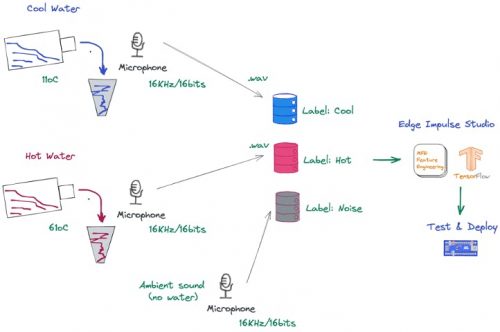- makeITcircular 2024 content launched – Part of Maker Faire Rome 2024Posted 2 weeks ago
- Application For Maker Faire Rome 2024: Deadline June 20thPosted 2 months ago
- Building a 3D Digital Clock with ArduinoPosted 7 months ago
- Creating a controller for Minecraft with realistic body movements using ArduinoPosted 7 months ago
- Snowflake with ArduinoPosted 8 months ago
- Holographic Christmas TreePosted 8 months ago
- Segstick: Build Your Own Self-Balancing Vehicle in Just 2 Days with ArduinoPosted 8 months ago
- ZSWatch: An Open-Source Smartwatch Project Based on the Zephyr Operating SystemPosted 9 months ago
- What is IoT and which devices to usePosted 9 months ago
- Maker Faire Rome Unveils Thrilling “Padel Smash Future” Pavilion for Sports EnthusiastsPosted 10 months ago
“Listen to temperatures” with TinyML
Can we “listen” a difference between pouring hot and cold water?
As you see in the video you can do it, but why? It is mentioned that the change is due to complex fluid dynamics reasons. Beyond the scientific investigation, the question we asked ourselves was: is this ability to “listen to temperatures” something that can be replicated using Artificial Neural Networks? We then tried to create an experiment using TinyML (Machine Learning applied to embedded devices).

We used very different water temperatures, with a range of 50 ° C between them. (11 ° C and 61 ° C); for each sample the listening time was the time taken by the glass to be filled (from 3 to 5 seconds). We are interested in capturing the sound of water only during the pouring process. The sound was recorded from the same digital microphone (sampling frequency: 16KHz) and stored as a .wav file in 3 different folders: cold water sound (“Cool”); sound of hot water (“Hot”); no sound of water (“Noise”).
The acquired dataset (via Arduino Nano 33 BLE Sense) was uploaded to Edge Impulse Studio, where it was preprocessed, the neural network (NN) model was trained, tested and deployed on an MCU for a real physical test (an iPhone was also used for live classification).















